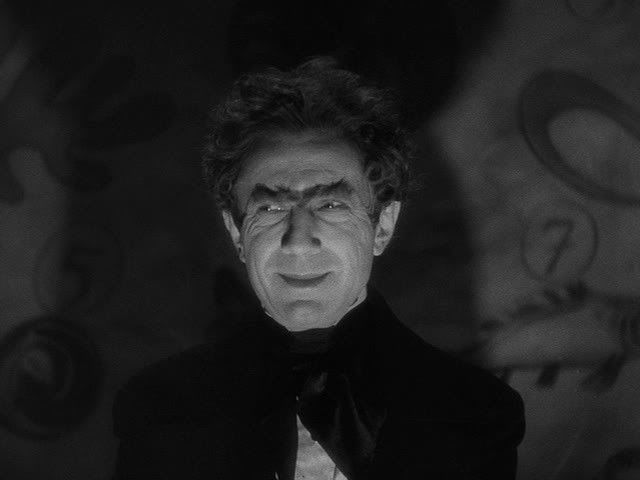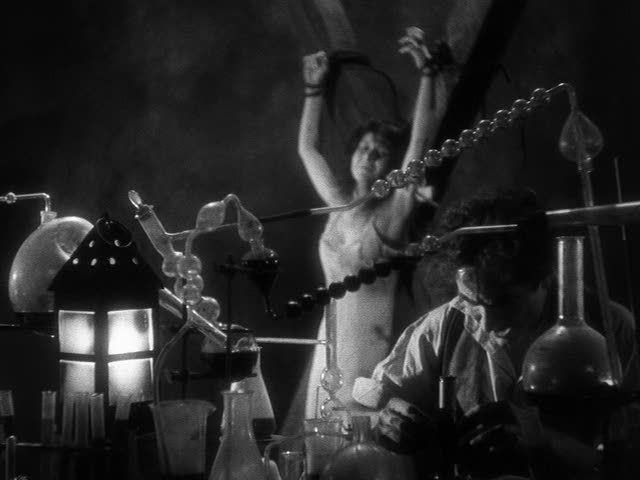
Murders in the Rue Morgue, very loosely based on the Edgar Allen Poe story of the same name, is a bizarre film in which its horror arises not so much from a monster or shadowy unnamed terror, but from the scientific lust to experiment. In fact, the source of evil in the film is the crazed Doctor Mirakle (the always creepy Bela Lugosi sporting an impressively bushy unibrow), a Darwinian scientist whose theories about evolution lead him to perform horrible experiments to mix the blood of his gorilla Erik with a human woman, thus proving, in his warped view, some evolutionary link between the two species. Darwin's theories had of course been around for quite some time when this film was made, but they were still far from uncontroversial, and the scene in which Mirakle advances his theories, to the disgust and horror of most of his audience, is doubtless an accurate reflection of how the people of the time viscerally reacted to the insinuations of Darwinian and Mendelian science about the connections between humans and their ape ancestors. In this sense, the film is perhaps an unlikely precursor to the body horror of David Cronenberg, since its horrific elements arise from the disgust with humanity's primal origins in the lowly ape. The film reflects contemporary paranoia about regression and inhumanity, the fear that if man is descended from these hairy, brutal, instinctual creatures, he might just as easily display the same traits.
Of course, there are other layers to these fears. The barely restrained subtext of these experiments is sexual as well as racial, expressing a fear of miscegenation and mixing bloodlines that is perhaps just as visceral — and just as rooted in its time — as the anti-Darwinian backlash. Mirakle's act of injecting gorilla blood into his female victims — who are chained to an X-shaped rack in his Gothic home — is creepily sexual, a violent act of penetration and fluid exchange. It is surely no coincidence that Mirakle's Igor-esque manservant is credited as Janos the Black and played by African-American character actor Noble Johnson, or that the film's introduction features the main characters taking in a carnival where exotic Arab and Indian caricatures perform for their amusement. Even Lugosi's ever-present accent is commented upon, with the carnival audience speculating about where he comes from. He is, like Janos and the ape, a signifier of the Other around which fears tend to develop. The film both reflects and slyly satirizes the fears of its doubtless primarily white audience, rooting its horror in very real sexual and racial boogeymen.
In this context, Mirakle's true evil lies in his desire to institute unnatural unions, to force mixing across blood barriers. In his quest to complete this experiment, however, he becomes obsessed with finding a "pure" woman to make his ape's bride. He initially assaults only prostitutes, a fact that this pre-Code film is surprisingly direct about, but realizes that their blood is impure, tainted by their "black sins," and the women all die following their symbolic rape by the gorilla. Mirakle and Janos dispose of the corpses by letting them drop through a trapdoor in the lab, sending them off into the river. Soon, Mirakle realizes that he needs a pure woman, a virgin presumably, and he becomes obsessed with the lovely Camille (Sidney Fox), who he stalks from afar even as her fiancé Pierre (Leon Ames) investigates the mysterious murders that are cropping up in the neighborhood.

As this simple plot is set into motion, the film occasionally drags, even within its economical one-hour running time, as too much time is spent with the utterly generic protagonists rather than with the memorable villain and his giant ape. Part of the problem is that the film was drastically censored before its release, cutting out around 20 minutes of scenes deemed too violent. Considering some of the scenes left in — the one where Mirakle injects and kills a prostitute is still bracing today — it's not hard to see why the studio executives balked at the film's bloodshed and mayhem. The result, though, is that the film is badly unbalanced, with too much of the actual horror chopped out, and too many of the insipid love scenes, which usually form a simple counterpoint to the darker material, overwhelming the film. As usual for horror films of the time, the romantic scenes are an almost total loss, with Ames even more of a laughable dud than most horror heroes — his attempts at a poetic seduction are unintentionally hilarious.
It is Lugosi, with his unvarying Hungarian accent, baroque mannerisms and smarmy smiles, who is the center of attention whenever he's onscreen. The scenes with Lugosi's eerie mad doctor also inevitably bring out the best in the expressionist set design, which director Robert Florey lovingly showcases with the aid of Hollywood's greatest expressionist cameraman, Karl Freund. The set of Mirakle's lab, with its X-shaped torture rack and obligatory rows of vaguely scientific-looking bottles and flasks, is a masterpiece of minimalist design. The cinematography exploits the lab's blank walls by projecting terrifying shadows on the bare surfaces when Mirakle is experimenting on his hapless victims. The mad doctor's shadow often precedes him, stretched out with an odd-shaped top hat and cloak to add sharp edges to his shadowy figure, creeping through the night in search of women to bring home.
Despite the weird intensity of the scenes with Mirakle, the film falters pretty much whenever he's offscreen. Florey brilliantly stages one of the film's crucial murders with a blurry, shaky closeup on the face of the ape murderer as it pounds its fist up and down on its unseen victim. But the sequence's aftermath is an absurd inquiry with a lackadaisical judge and a trio of ethnic caricatures who give varying accounts of what happened while playing up their outrageous accents and exaggerated gestures: the one guy wouldn't really be Italian if he didn't keep biting his knuckles in rage, right? This is one of the few scenes that is directly derived from Poe's original story — all of the witnesses misidentify the language the killer was shouting in, because of course the killer was an ape — but it's dragged out and sloppily executed. Most viewers who haven't read the original Poe story would probably miss the meaning of this ethnic bantering, writing it off as the silly comic relief it comes across as. The film feels padded with nonsense scenes like this, including pretty much all of the jokey interludes with Pierre and his roommate (Bert Roach), with whom he has an almost marital domestic arrangement. Still, Lugosi alone would make the film worth seeing, giving yet another of the kind of fun, mannered performances he'd deliver in all his 30s appearances at Universal. And at its best moments the film is visually beautiful, disguising its charmingly artificial Paris sets with a heavy coating of fog that creates a tense, uncertain atmosphere.
No comments:
Post a Comment